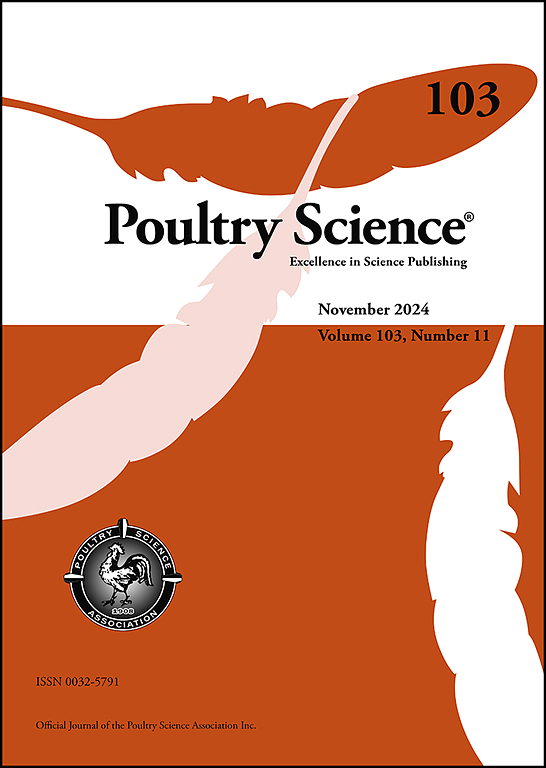Pharmacokinetics of difloxacin in Sichuan Shelducks after single or multiple dosing
IF 4.2
1区 农林科学
Q1 AGRICULTURE, DAIRY & ANIMAL SCIENCE
引用次数: 0
Abstract
This study evaluated both single and multiple dosing regimens of difloxacin administered via different routes to Sichuan Shelducks: single intramuscular (sIM), intravenous (sIV), oral gavage (sPO), and multiple intramuscular (mIM) and oral gavage (mPO) administrations. The sIV, sPO, and sIM groups received a single dose of difloxacin at 10 mg/kg body weight (BW). The mPO and mIM groups received multiple doses of 10 mg/kg BW at 12-hour intervals: the mPO group received 10 oral doses, and the mIM group received 6 intramuscular doses. Blood samples were collected at various time points from 0 to 48 hours, and plasma concentrations of difloxacin were analyzed using a validated high-performance liquid chromatography (HPLC) method. Pharmacokinetic parameters were calculated using Phoenix software and non-compartmental analysis (NCA). The peak plasma concentration (Cmax) values were 2.05 ± 0.60, 2.26 ± 0.36, 2.81 ± 0.92, and 3.42 ± 0.59 μg/mL for the sPO, sIM, mPO, and mIM groups, respectively, with corresponding peak time (tmax) of 0.75 ± 0.17, 0.77 ± 0.26, 0.96 ± 0.61, and 0.65 ± 0.33 hours. The PO and IM bioavailability (F) after single administration were 96.00 % ± 22.03 % and 87.62 % ± 9.81 %, respectively. Following single IV administration, difloxacin exhibited extensive distribution, with a volume of distribution (VZ) of 6.12 ± 3.59 L/kg and a steady-state volume of distribution (VSS) of 3.18 ± 1.09 L/kg. Difloxacin was eliminated slowly, with terminal half-lives (t1/2λz) of 10.77 ± 1.78, 4.53 ± 4.44, 4.53 ± 2.97, 6.00 ± 2.00, and 5.33 ± 4.35 hours in the sPO, sIM, sIV, mPO, and mIM groups, respectively. Based on the AUC/MIC ratios, the current single IV and PO dosing regimens, as well as the multiple IM and PO regimens, appear effective against pathogens with MIC values ≤ 0.1 μg/mL. However, the single IM dose of 10 mg/kg BW may be inadequate for treating infections caused by organisms with MIC values > 0.1 μg/mL.
双氟沙星在川鸭体内单次或多次给药的药动学
本研究评估了通过不同途径给四川鸭单次和多次给药方案:单次肌注(sIM)、静脉注射(sIV)、灌胃(sPO)以及多次肌注(mIM)和灌胃(mPO)给药。sIV组、sPO组和sIM组给予单剂量双氟沙星10 mg/kg体重(BW)。mPO组和mIM组每隔12小时给药10 mg/kg BW, mPO组口服10次,mIM组肌注6次。在0 ~ 48小时的不同时间点采集血样,采用高效液相色谱(HPLC)方法分析血浆中双氟沙星的浓度。采用Phoenix软件和非区室分析(NCA)计算药代动力学参数。sPO、sIM、mPO、mIM组血药浓度峰值分别为2.05±0.60、2.26±0.36、2.81±0.92、3.42±0.59 μg/mL,血药浓度峰值时间分别为0.75±0.17、0.77±0.26、0.96±0.61、0.65±0.33 h。单次给药后PO和IM的生物利用度F分别为96.00%±22.03%和87.62%±9.81%。单次静脉给药后,双氟沙星分布广泛,分布体积(VZ)为6.12±3.59 L/kg,稳态分布体积(VSS)为3.18±1.09 L/kg。双氟沙星消除缓慢,sPO、sIM、sIV、mPO、mIM组的终末半衰期(t1/2λz)分别为10.77±1.78、4.53±4.44、4.53±2.97、6.00±2.00、5.33±4.35 h。从AUC/MIC比值来看,当前单次给药和单次给药方案以及多次给药方案对MIC值≤0.1 μg/mL的病原体均有效。然而,10 mg/kg体重的单次IM剂量可能不足以治疗由MIC值的生物体引起的感染。0.1μg / mL。
本文章由计算机程序翻译,如有差异,请以英文原文为准。
求助全文
约1分钟内获得全文
求助全文
来源期刊

Poultry Science
农林科学-奶制品与动物科学
CiteScore
7.60
自引率
15.90%
发文量
0
审稿时长
94 days
期刊介绍:
First self-published in 1921, Poultry Science is an internationally renowned monthly journal, known as the authoritative source for a broad range of poultry information and high-caliber research. The journal plays a pivotal role in the dissemination of preeminent poultry-related knowledge across all disciplines. As of January 2020, Poultry Science will become an Open Access journal with no subscription charges, meaning authors who publish here can make their research immediately, permanently, and freely accessible worldwide while retaining copyright to their work. Papers submitted for publication after October 1, 2019 will be published as Open Access papers.
An international journal, Poultry Science publishes original papers, research notes, symposium papers, and reviews of basic science as applied to poultry. This authoritative source of poultry information is consistently ranked by ISI Impact Factor as one of the top 10 agriculture, dairy and animal science journals to deliver high-caliber research. Currently it is the highest-ranked (by Impact Factor and Eigenfactor) journal dedicated to publishing poultry research. Subject areas include breeding, genetics, education, production, management, environment, health, behavior, welfare, immunology, molecular biology, metabolism, nutrition, physiology, reproduction, processing, and products.
 求助内容:
求助内容: 应助结果提醒方式:
应助结果提醒方式:


